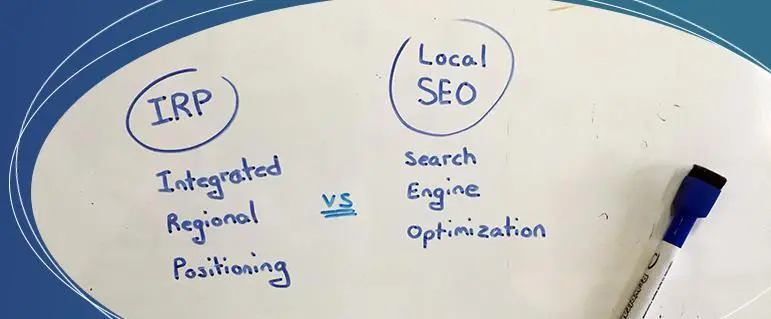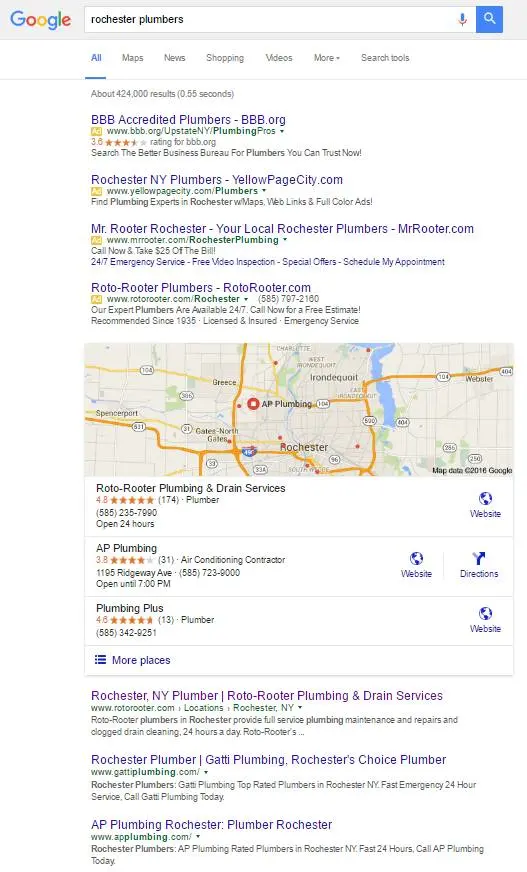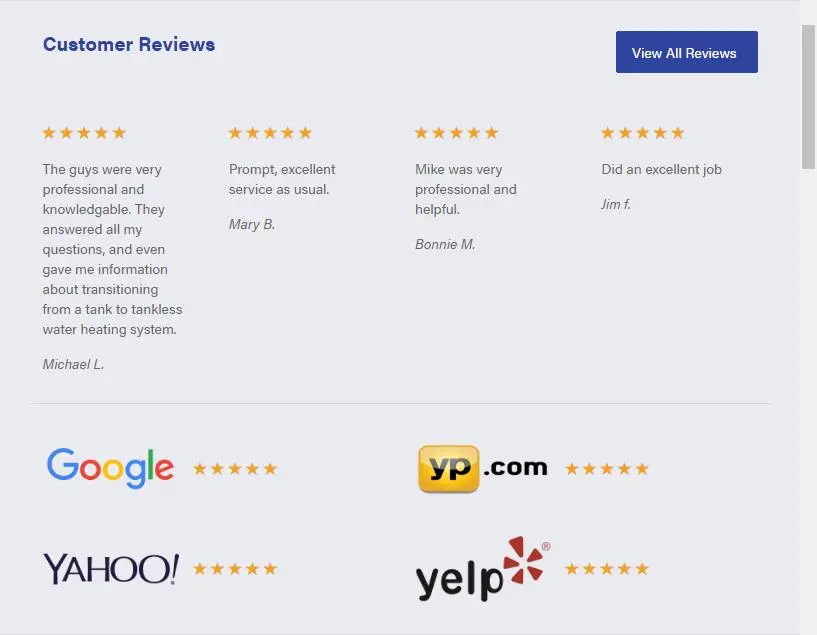Why Local SEO Is Dead and What Is Taking Its Place
In simple terms, the goal of your online marketing, as with all your marketing, should be about more than just getting more visitors to your website. It should be to increase the amount of business you’re getting from the web. More clients, customers, or patients, and therefore, more sales. This is why Local SEO as we know it, is dead.
If you own a local business, one that primarily provides goods or services to a particular city, town, or geographic region, you probably are familiar with the term Local SEO, or local search engine optimization. A common definition of SEO, as it relates to marketing a local business, is doing what’s necessary to get the business website found in local search listings as well as national search engines like Google, Yahoo, and Bing whenever someone types a search query related to that business into their search bar.
The problem with that definition, as well as the activities it defines, is that the thinking it is far too narrow to adequately identify and accomplish the objective of building your business. Because that IS the real goal, isn’t it? Not just getting eyes on your web pages, but actually building your business?
Local SEO is Dead – Long Live I.R.P.
If increasing sales is the goal, then it follows that relying on the tactics of search optimization won’t cut it. In other words, as far as you and your business are concerned, local SEO is dead, and it should be. Why? Because all those tactics can do is improve your web page’s position in the search engines, which effectively does next to nothing (by itself) to actually get new prospects to pick up the phone and call you, or to visit your business or practice.
Accomplishing that requires a much broader approach, a wide- and far-reaching strategy I like to call Integrated Regional Positioning, or IRP.
IRP – Integrated Regional Positioning
The principles behind IRP are simple. There’s nothing new here, really, at least not fundamentally. What is new is the idea that these tactics can and should be looked at as one cohesive whole… the idea of POSITIONING your business in such a way, using an INTEGRATED approach that blends several specific and separate tactics, in order to achieve REGIONAL dominance.
In fact, by saying that, we now have a clear, concise definition of IRP.
Integrated Regional Positioning means POSITIONING your business in such a way, using an INTEGRATED approach that blends several specific and separate tactics, in order to achieve REGIONAL search and social dominance.
The Three Stages of IRP – STRATEGY
Before we get into the tactics involved, I want to outline what I believe are the three stages of IRP. No matter where you are beginning, whether you run an established business or a brand new startup, you should seek to establish the following stages, ALWAYS in the same order.
- TRUST
Establishing trust in the eyes of your potential clients or customers is the primary goal of the first stage of IRP. There are many facets to this, including organic search presence, social media presence, local citations and business listings, map and places listings, and of course, reviews. - AUTHORITY
Becoming THE, or at least A, recognized authority in the regional niche/marketplace is the second stage. - DOMINANCE
Establishing search and social dominance is the third and final IRP stage, and becomes the default position of the company in the mind of the local marketplace.
Together, these three stages define the STRATEGY of Integrated Regional Positioning. Below, we will explore some of the tactics used to achieve the strategic objectives of IRP.
IRP in Practice – TACTICS
There are several specific tactics used to earn and increase TRUST, gain niche AUTHORITY, and establish DOMINANCE. Due to dramatic differences in types of business, local factors, and current business position, there is no set order as to when and how these tactics are deployed.
Prior to setting a deployment schedule, an in-depth strategic analysis of these factors must be performed, and a resulting tactical game-plan must be developed. Below is a typical order in which the tactics might be applied:
1.Keyword and competition research
In the earliest stages, the business’s primary, secondary, and tertiary search terms must be identified, and the primary competition must be identified and thoroughly researched. This step is a pre-requisite to the remaining steps.
2. Website and on-page search analysis and optimization
A careful analysis of the firm’s existing website(s) is performed, and the content is analyzed as it relates to the keywords identified in the step above. Content and images are adjusted for optimum search engine relevance.
3. Conversion analysis and optimization
What’s the purpose of bringing a new visitor to the website or web page, if that page is ineffective at converting the visitor to a prospect, and from a prospect into a client, patient, or customer? The existing webpages must be analyzed and adjusted with an eye toward maximizing conversions.
4. Marketing analytics setup and fine-tuning
There must be a strategy for keeping track of, and thoroughly understanding, where all traffic is coming from, and how much real traffic there is. This needs to be differentiated from bot and spam traffic.
5. Current trust/authority analysis
What is the business’s current level of TRUST and AUTHORITY in the marketplace? How do current customers, prospects, and the general population view and understand the business, especially compared with the strongest competitors?
6. Current loyalty/retention analysis
How loyal is the current client base? What is the average lifetime value? Of a customer? How long does the average customer continue with the firm? What methods are currently being used to improve and insure loyalty and retention?
7. Trust and review strategy implementation
This critical step involves establishing, systematizing, and automating a review gathering program and platform, garnering user and customer reviews from the most satisfied clients, and identifying and problem-solving with those who may be dissatisfied.
8. Social stacking strategy implementation
This step includes creating and optimizing the business’s social platforms, such as Facebook and YouTube. Niche specific platforms like Yelp, OpenTable, And TripAdvisor are included at this time.
9. Email marketing strategy implementation
At some point concurrent with the above two steps, the firm’s email marketing platform will be implemented, allowing nearly instant communication with the firm’s current customer base, as well as development of a prospecting database for marketing-funnel purposes.
10. Organic search optimization strategy implementation
An aggressive campaign of organic search optimization, with an emphasis on relevant link-building, video deployment, LSI (Latent Semantic Indexing) mentions, press releases, and private network development. The goal of this step is dominance of the first page of the SERPs (search engine results pages).
Why IRP Works
To see an example of why IRP is such an effective online marketing approach, let’s consider an imaginary example. Let’s say I’m a resident of the Rochester, NY region, and I’m looking for a plumber. Let’s also assume you own a plumbing contracting firm in the Rochester region.
OK, so to begin my search, I head over to my favorite search engine and type in “Rochester plumbers” to see what comes up. Here’s a screenshot of the top results in Google…
As an “average searcher” I would likely disregard the ads at the top of the page, because I know they’re paid advertisements and therefore, maybe not as trustworthy as the organic listings.
So, what do I see in the map listings and the organic listings at the top of the first page? Obviously, I see Roto-Rooter with 174 reviews and a rating of 4.8, basically blowing away the nearest competition. I also see that the Roto-Rooter website is the top organic listing, too. So I click through to the Roto-Rooter website to check it out.
The first thing I see, at the very top of the page, in red font color, is their phone number. Not once, but TWICE. I also see that I can easily schedule service right there, on the webpage. In addition, I see a list of FIVE REASONS to TRUST Roto-Rooter. All this, without scrolling down the page. Talk about effective conversion.
Not only that, if I do choose to scroll down the page, I see a highly effective section focusing on their online reviews. See the screenshot below.
TRUST has been built, AUTHORITY has been established. I can see that Roto-Rooter is obviously the DOMINANT player in the niche, and not just because they’re ranked at the top, but because I am basically seeing them everywhere, and I am seeing, with my own eyes, that a huge number of my neighbors are already trusting them with the same kind of plumbing problem that I have.
Do you see how powerful this is? After all, there are plenty of other plumbers ranked right there, on the first page. I could have, and I may have, taken a few minutes to check them out, but I really didn’t need to, did I? My decision is basically made for me.
Of course, this is a highly-simplified example, and there are a lot more factors involved, and even more variables that determine what each individual searcher is looking for, and what they do when they find it. But you get the idea.
Conclusion
So now what? If you’re a business owner, what do you do with this information?
Well, obviously, this brief article affords only a brief overview of the concepts involved, and in-depth discussion is beyond our scope. It is, however, a great place to start for the business owner or manager who wants to perform the firm’s SEO and online marketing in-house, or who is interested in finding a qualified agency to out-source to.
No matter what, whether taking on the task yourself, or hiring a consultant or agency, hopefully you have a heightened appreciation of the Integrated Regional Positioning model of achieving and maintaining dominance in the online space.
As you can see, there’s a lot more involved than just SEO.



